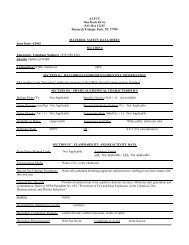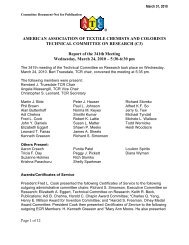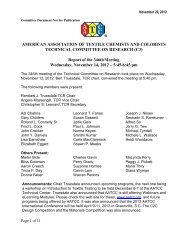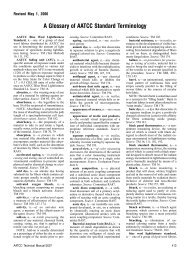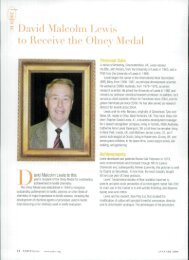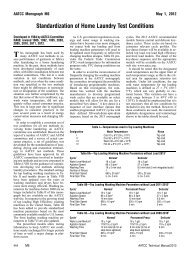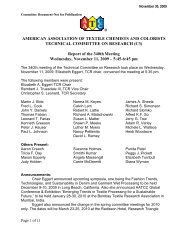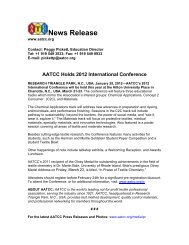Robert J. Harper Jr. - AATCC. American Association of Textile ...
Robert J. Harper Jr. - AATCC. American Association of Textile ...
Robert J. Harper Jr. - AATCC. American Association of Textile ...
You also want an ePaper? Increase the reach of your titles
YUMPU automatically turns print PDFs into web optimized ePapers that Google loves.
<strong>AATCC</strong>'s 1991 International Conference & Exhibition<br />
<strong>Robert</strong> J. <strong>Harper</strong> <strong>Jr</strong>. To Receive The Olney Medal<br />
<strong>Robert</strong> J. <strong>Harper</strong> <strong>Jr</strong>., a lead scientist in<br />
the textile finishing group at the<br />
U.S, Department <strong>of</strong> Agriculture's Southern<br />
Regional Research Center at New<br />
Orleans, has been named the 1991 recipient<br />
<strong>of</strong> The Olney Medal in recognition <strong>of</strong><br />
the many contributions he has made to<br />
improving the chemical finishing <strong>of</strong> cotton<br />
and cotton blends.<br />
The eldest <strong>of</strong> ten children. <strong>Harper</strong> was<br />
born in 1930 in Savannah, Ga., and<br />
attended parochial schools there. He holds<br />
a BS in chemistry from Fordham University,<br />
graduating magna cum laude in 1952,<br />
and a doctorate in organic chemistry from<br />
OhioStale University (1957).<br />
Prior to joining USDA in 1963, he<br />
served 17 months as a First Lieutenant in<br />
the U.S. Air Force, working as a project<br />
<strong>of</strong>ficer at the Air Force Office <strong>of</strong> Scientific<br />
Researeh in Washington, D. C. From<br />
January 1958 to October 1961 he was<br />
employed as a research chemist at Ethyl<br />
Corp. in Baton Rouge, La. From October<br />
1961 until October 1963 he was a civilian<br />
scientist at the Air Force Materials Laboratory<br />
in Dayton. Ohio. While at Ethyl<br />
Corp. and at the materials laboratory in<br />
Dayton, his research was on organometallic<br />
chemistry.<br />
At SRRC he has served as a research<br />
chemist and project leader (1963-73) and<br />
research leader for several different<br />
groups (pilot plant processing, special<br />
products research and fabric systems)<br />
(1973-85). Since 1985 he has been in<br />
charge<strong>of</strong>the textile pilot plant operation.<br />
<strong>Harper</strong>'s work at SRRC has ranged<br />
from yarn and fabric formation to experimental<br />
finishing to larger scale finishing in<br />
pilot plant operations. Particular areas <strong>of</strong><br />
research over the years include abrasion<br />
resistant DP cottons, use <strong>of</strong> polymer additives<br />
in finishing, use <strong>of</strong> reactive additives<br />
in finishing for improved soil release and<br />
dyeabiiity after finishing, improved moisture<br />
related properties, permanent polymer<br />
sizes, cross dyeable fabrics, chemicals<br />
for improved processing, FR finishing <strong>of</strong><br />
blend fabrics, FR and mildew resistant<br />
finishes foroutdoorcotton fabrics, various<br />
techniques for low wet add-on finishing,<br />
approaches for reducing formaldehyde<br />
relea.se, processes for producing smolder<br />
resistant cotton, heat transfer printing <strong>of</strong><br />
cellulosic fabrics and finishing <strong>of</strong> core yarn<br />
fabrics.<br />
Recent research has focused on the<br />
development <strong>of</strong> processes for producing<br />
durable press/flame retardant fabrics for<br />
military applications and development <strong>of</strong><br />
September 1991 CCO<br />
systems for dyeable smooth dry fabrics<br />
utilizing cationic grafts. The latter systems<br />
have been extended to techniques for<br />
differential dyeing, print dyeing, multicolor<br />
dyeing and to methods for producing<br />
generic cotton fabrics that are cross dyeable.<br />
Other recent garment dyeing work<br />
has been related to development <strong>of</strong> single<br />
sided treatments for garment dyeing, systems<br />
applicable to garment dyeing <strong>of</strong><br />
blends, stone dyeing and rope finishing <strong>of</strong><br />
fabrics. The originality <strong>of</strong> this work is<br />
evidenced by the fact that <strong>of</strong> his nearly 200<br />
publications, 39 arc U.S. patents.<br />
In addition to his papers, patents and a<br />
book on durable press finishing. <strong>Harper</strong><br />
has made more than 50 presentations at<br />
scientific meetings <strong>of</strong> the <strong>American</strong><br />
Chemical Society, the Fiber Society, the<br />
Cotton Council and the Industrial Fabrics<br />
<strong>Association</strong> International, among others.<br />
He has presented some 15 papers to<br />
national <strong>AATCC</strong> meetings and has spoken<br />
to a number <strong>of</strong> <strong>AATCC</strong> section<br />
meetings. He organized four textile related<br />
symposia for ACS and chaired the<br />
technical session on formaldehyde release<br />
at <strong>AATCC</strong>'s 1983 National Technical<br />
Conference at New Orleans.<br />
He has been the recipient <strong>of</strong> a number <strong>of</strong><br />
citationsand awards including the Federal<br />
Businessman's Distinguished Service<br />
Group Award from the Cotton Transfer<br />
PrintingGroupin 1982; SRRC's Technology<br />
Transfer Award for Work on Cationic<br />
Cotton in 1987;and 1990 Employee <strong>of</strong>the<br />
Year for leadership <strong>of</strong> research in a broad<br />
ROBERT HARPER has been a research scientist<br />
at USDA's Southern Regional Research<br />
Center since 1963.<br />
area <strong>of</strong> textile finishing. He was elected to<br />
Phi Lamda Upsilon in 1955 and to Sigma<br />
Xi in 1965.<br />
As a member <strong>of</strong> <strong>AATCC</strong>'s Gulf Coast<br />
Section. <strong>Harper</strong> has been active as a<br />
research committee chairman, judge and<br />
speaker in several <strong>of</strong> the association's<br />
Intersectional Technical Paper Competitions.<br />
He also served as a member <strong>of</strong> the<br />
host committee for national conferences<br />
held in New Orleans in 1967, 1974 and<br />
1983. In 1989-90 he was vice-chairman for<br />
the Gulf Coast Section.<br />
<strong>Harper</strong> is married to the former Ramona<br />
Keiser <strong>of</strong> Columbus, Ohio. They<br />
have six children: Theresa Ray. a legislative<br />
research analyst for the State <strong>of</strong><br />
Louisiana in Baton Rouge; Margaret<br />
Tarantolo, a geophysicist for Exxon in<br />
Houston, Tex.; Agnes Lawrence, a medical<br />
technician in Marks. Miss,; <strong>Robert</strong>, a<br />
petroleum engineer for Exxon in New<br />
Orleans; Daniel, an industrial engineer for<br />
Packard Electric in Clinton. Miss.; and<br />
Dorothy, a travel nurse in Winston-Salcm.<br />
N. C. They also have ten grandchildren.<br />
In addition to family and church activities.<br />
<strong>Harper</strong>'s interests include square<br />
dancing, jogging, gardening and bird<br />
watching.<br />
The Olney Medal<br />
Established in 1944 in honor <strong>of</strong> Dr. Louis<br />
Atwell Olney, the founder and first president<br />
<strong>of</strong> <strong>AATCC</strong>. The Olney Medal is<br />
presented in recognition <strong>of</strong> outstanding<br />
achievement in textile or polymer chemistry<br />
or other fields <strong>of</strong> chemistry <strong>of</strong> major<br />
importance to textile science.<br />
Presentation <strong>of</strong> the medal each year is a<br />
highlight <strong>of</strong> <strong>AATCC</strong> conferences. This<br />
year's presentation will be made at the<br />
conference awards luncheon on Wednesday,<br />
October 9, Immediately following the<br />
luncheon. <strong>Harper</strong> will deliver the traditional<br />
Olney Medal Address. His topic will<br />
be Crosslinking, Grafting and Dyeing:<br />
Finishing for Added Properties.<br />
Previous Reeipients<br />
<strong>Harper</strong> is the forty-eighth recipient <strong>of</strong> The<br />
Olney Medal. The first award was to<br />
Dr. Olney in 1944. Since then it has been<br />
awarded to:<br />
1945—Milton Harris, Milton Harris<br />
Associates<br />
1946—William A. Cady. U.S. Finishing<br />
Co.<br />
1947—Edward A. Schwarz, Massachusetts<br />
Institute <strong>of</strong>Technology<br />
continued on page 54<br />
51
for finishing.<br />
1983—^Valentin Appenzeller, inventor<br />
<strong>of</strong> the swimming roll concept for overcomingdeflections<br />
<strong>of</strong> opposing rolls in padders.<br />
1984—Victor F. Fahringer, inventor <strong>of</strong><br />
the jet dyeing machine.<br />
1985~Herman B. Goldstein <strong>of</strong> HBG<br />
Export Corp. for development <strong>of</strong> a low cost<br />
process for manufacturing dimethylol dihydroxyethylene<br />
urea (DMDHEU) and<br />
his discovery that DMDHEU was ideally<br />
suited for use as a cellulose crosslinker.<br />
1986—Andrew G. Pierce <strong>Jr</strong>. and<br />
John G. Frick <strong>Jr</strong>. <strong>of</strong> the U.S. Department<br />
<strong>of</strong> Agriculture's Southern Regional Research<br />
Center for their development <strong>of</strong><br />
magnesium chloride-hydroxy acid mixed<br />
catalyst systems for durable press finishing.<br />
1987—Dietrich R. Hildebrand <strong>of</strong><br />
Bayer AG for his work on the fundamentals<br />
and techniques <strong>of</strong> reactive dyeing.<br />
1988—Hugh R. Davidson and Henry<br />
Hemmendinger, developers <strong>of</strong> the first<br />
successful color matching computer system.<br />
1989—Winfried T. Holfcld <strong>of</strong> Du Pont<br />
for contributions in improving the dye<br />
uniformity <strong>of</strong> nylon and polyester fabries.<br />
1990—Ulrich W. Meyer <strong>of</strong> the Swiss<br />
Federal Institute <strong>of</strong> Technology in Zurich<br />
for tracing the cause <strong>of</strong> catalytic damage<br />
to cotton fabrics during peroxide bleaching<br />
and largely eliminating the problem.<br />
from page 51<br />
The OIney Medal<br />
1948—Harold M. Chase, Dan River<br />
Mills<br />
1949—Charles A. Seibert, The Du Pont<br />
Co.<br />
1950—George L. Roycr, <strong>American</strong> Cyanamid<br />
Co.<br />
1951 —Raymond W. Jacoby. Ciba Co.<br />
1952—Werner von Bergen, Forstmann<br />
Woolen Co.<br />
1953—Roland E. Derby Sr., The Derby<br />
Co.<br />
1954—William D. Appel, National Bureau<br />
<strong>of</strong> Standards<br />
1955—Miles A. Dahlen, The Du Pont<br />
Co.<br />
1956—Walter J. Hamburger, Fabric<br />
Research Laboratories<br />
1957—P. J. Wood, Royce Chemical<br />
Co.<br />
1958—Henry E. Millson, <strong>American</strong><br />
Cyanamid Co.<br />
1959—^Emery I. Valko, Lowell Technological<br />
Institute<br />
1960—Arnold M. Sookne, Harris Research<br />
Laboratories<br />
1961—Fred Fortess, Celanese Corporation<br />
<strong>of</strong> America<br />
<strong>AATCC</strong>'s 1991 International Conference & Exhibition<br />
1962—Charles F. Goldthwait. North<br />
Carolina State University<br />
1963—Guiliana C. Tesoro, J. P.<br />
Stevens & Co.<br />
1964—Richard O. Steele. Rohm and<br />
Haas Co.<br />
1965—Herman F. Mark, Polytechnic<br />
Institute <strong>of</strong> Brooklyn<br />
1966—Wilson A. Reeves, U.S. Department<br />
<strong>of</strong> Agriculture<br />
1967—Edwin 1. Stearns, <strong>American</strong> Cyanamid<br />
Co.<br />
1968—Harold P. Lundgren, U.S. Department<br />
<strong>of</strong> Agriculture<br />
1969—D. Donald Gagliardi, Gagliardi<br />
Research Corp.<br />
1970—Paul L. Meunier, TheDu Pont<br />
Co.<br />
1971-Ernest R. Kaswell, Fabric Research<br />
Laboratories<br />
1972—Victor S. Salvin, University <strong>of</strong><br />
North Carolina at Greensboro<br />
1973—Herman B. Goldstein, Sun<br />
Chemical Corp.<br />
1974—Henry A. Rutherford, North<br />
Carolina State University<br />
1975—R. Lee Wayland <strong>Jr</strong>., Dan River<br />
Inc.<br />
1976—George L. Drake <strong>Jr</strong>., U.S. Department<br />
<strong>of</strong> Agriculture<br />
1977—James M. Straley. Tennessee<br />
Eastman Co.<br />
1978—Dmitry M. Gagarine, Milliken<br />
Research Corp.<br />
1979—Joseph W. Gibson <strong>Jr</strong>., The<br />
Du Pont Co.<br />
1980—Roland E. Derby <strong>Jr</strong>., The Derby<br />
Co.<br />
1981—Mathias J. Schuler, The<br />
Du Pont Co.<br />
1982—Stephen B. Sello, J. P.<br />
Stevens & Co.<br />
1983—Theodore F. Cooke, <strong>Textile</strong> Research<br />
Institute<br />
1984—Ralph McGregor, North Carolina<br />
State University<br />
1985—Stanley P. Roland, U.S. Department<br />
<strong>of</strong> Agriculture<br />
1986—Melvin D. Hurwitz, University<br />
<strong>of</strong> North Carolina at Greensboro<br />
1987—Ludwig Rebenfeld, <strong>Textile</strong> Research<br />
Institute<br />
1988—Martin K. Lindemann, Consultant<br />
1989—J. Lee Rush, Allied-Signal Inc.<br />
1990—Hans-Dietrich Wcigmann,<br />
<strong>Textile</strong> Research Institute<br />
from page 52<br />
Railroads and Stars<br />
The Chapin Award<br />
Patton has spent much <strong>of</strong> his leisure time<br />
over the years pursuing two passionate<br />
hobbies; astronomy and railroading. For<br />
the past nine years he has been a director <strong>of</strong><br />
the National Railway Historical Society.<br />
The group meets three times a year in<br />
various cities across the country. Its<br />
Greensboro chapter puts on yearly steam<br />
engine excursions carrying up to a thousand<br />
passengers on day long main line<br />
trips. Theclubowns several passenger cars<br />
which have been restored by its members<br />
and leased to the Norfolk Southern Railroad<br />
for excursion service. One <strong>of</strong> the<br />
club's rolling stock is an old Cone Mills<br />
boxcar.<br />
He has been a member <strong>of</strong> the Greensboro<br />
Astronomy Club for almost 40 years,<br />
serving several times as its president. He<br />
also was a team leader for two years for a<br />
satellite tracking group during the early<br />
days<strong>of</strong>NASA.<br />
He also is a member <strong>of</strong> Carolina Model<br />
Railroaders and has a large HO layout in<br />
his basement. As a member <strong>of</strong> the Carolina<br />
<strong>Association</strong> for Passenger Trains, he<br />
has helped promote the use (or reuse) <strong>of</strong><br />
passenger trains, The group was instrumental<br />
in getting the Amtrak Carolinian<br />
train running again between Richmond<br />
and Charlotte.<br />
Patton is active in the Boy Scouts,<br />
serving as a merit badge counselor for<br />
astronomy. Hcisamember<strong>of</strong>Our Lady <strong>of</strong><br />
Grace Catholic Church in Greensboroand<br />
a past member <strong>of</strong> the parish advisory<br />
board. He is a past Grand Knight for the<br />
Knights <strong>of</strong> Columbus and a past Faithful<br />
Navigator for the Fourth Degree Knights<br />
<strong>of</strong> Columbus.<br />
As an extension <strong>of</strong> his hobbies, Patton<br />
has presented talks with slides to clubs,<br />
school classes, scouts and various other<br />
organizationson such topics as astronomy,<br />
railroadsand trains, and wildflowers.<br />
"Photography has been a fun project for<br />
me both at Cone Mills and <strong>AATCC</strong>,"<br />
Patton points out. "Probably my first<br />
<strong>AATCC</strong> contribution was a series <strong>of</strong> color<br />
photographs to illustrate a Piedmont Section<br />
paper on naphthol crocking in 1953.<br />
Many times 1 have made slides for my own<br />
talks and presentations and those <strong>of</strong> others<br />
giving papers for <strong>AATCC</strong>, such as Hobart<br />
Souther and Bill Weaver.<br />
"The most pleasure I've had was making<br />
the eover for the April 1983 issue <strong>of</strong><br />
<strong>Textile</strong> Chemist and Colorist. That was<br />
the April Fool shot <strong>of</strong> a scanning electron<br />
photomicrograph <strong>of</strong> cotton fibers in color.<br />
"I did a wide range <strong>of</strong> photographs for<br />
Cone throughout my years there. During<br />
the 1980s 1 started in video work on test<br />
method problems and as a training tool<br />
showing testing techniques."<br />
ASTM Too<br />
<strong>AATCC</strong> hasn't been the only beneficiary<br />
<strong>of</strong> Patton's willingness to share his exper-<br />
54 ceo Vol. 23, No. 9



